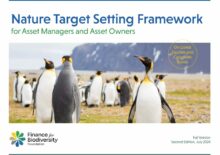The Finance for Biodiversity (FfB) Foundation is proud to announce the launch of the second edition of the “Nature Target Setting Framework for Asset Managers and Asset Owners,” unveiled during a webinar on July 3, 2024. This event featured prominent FfB Foundation members and showcased the significant advancements made since the beta version’s release in November 2023.
Building on the initial guidelines, this second edition represents a major step forward in empowering investors to set ambitious nature targets. It enhances the original framework and introduces new elements to help financial institutions align their investments with nature targets, reinforcing the urgent need to halt and reverse biodiversity loss by 2030.
“We are incredibly proud to have developed this second edition of the framework in collaboration with our dedicated members. It represents a collective effort to provide investors with the necessary tools to start developing and disclosing ambitious nature targets. Our signatories to the FfB Pledge are committed to disclosing their first targets by 2025, marking a significant step towards halting and reversing biodiversity loss and promoting sustainable investment practices.”, says Anita de Horde, Executive Director of FfB Foundation.
Key updates in this edition include:
- Three Types of Nature Targets: The framework adapts key targets into three categories—initiation targets, monitoring targets, and portfolio targets—providing a clear path towards the implementation of comprehensive portfolio targets.
- Unified Approach: The revised framework replaces the concept of beginner and advanced tracks with a unified approach, ensuring that all targets are geared towards being achieved by 2030, in alignment with the Global Biodiversity Framework.
- New ENCORE data: The framework includes new ENCORE data (version June 2024) with an overview of the materiality of each impact driver on nature of the priority sectors.
- Impact Drivers Identification: The framework identifies three impact drivers on nature that are material for the 10 priority sectors and for which there is already available data: land use change, volume of water use, and emission of toxic soil and water pollution.
- Data-Driven Target Setting: It establishes that sufficient data exists to start setting targets on these impact drivers, presenting concrete examples for investors.
- Detailed Guidance and Support: The framework offers comprehensive examples, processes, and detailed support to assist investors in setting effective nature targets.
This new edition underscores the FfB Foundation’s commitment to providing asset managers and asset owners with the tools and guidance needed to contribute meaningfully to global biodiversity goal
“As investors navigate the net zero transition, they need to address nature impacts beyond climate change. There is little good practice on how to do this as global investors. Robeco therefore warmly welcomes this guidance for setting our next steps in contributing to the transition towards a sustainable economy,” says co-chair of the Target Setting working group, Lucian Peppelenbos (Robeco).
“Nature’s continued decline poses material financial risks to the economy and financial markets. Setting targets on nature provides a mechanism of accountability to evidence how investors are addressing key nature-related impacts, dependencies, risks and opportunities across their investment portfolios. Fidelity International welcomes this guidance as a means to inform the natural evolution of our existing work in this space,” says co-chair of the Target Setting working group, Charlotte Apps (Fidelity International).







